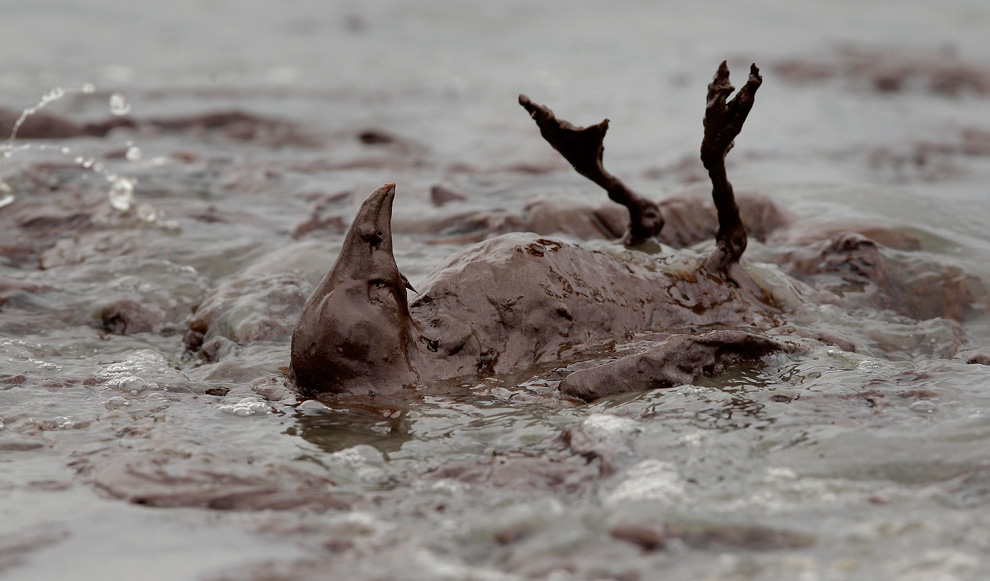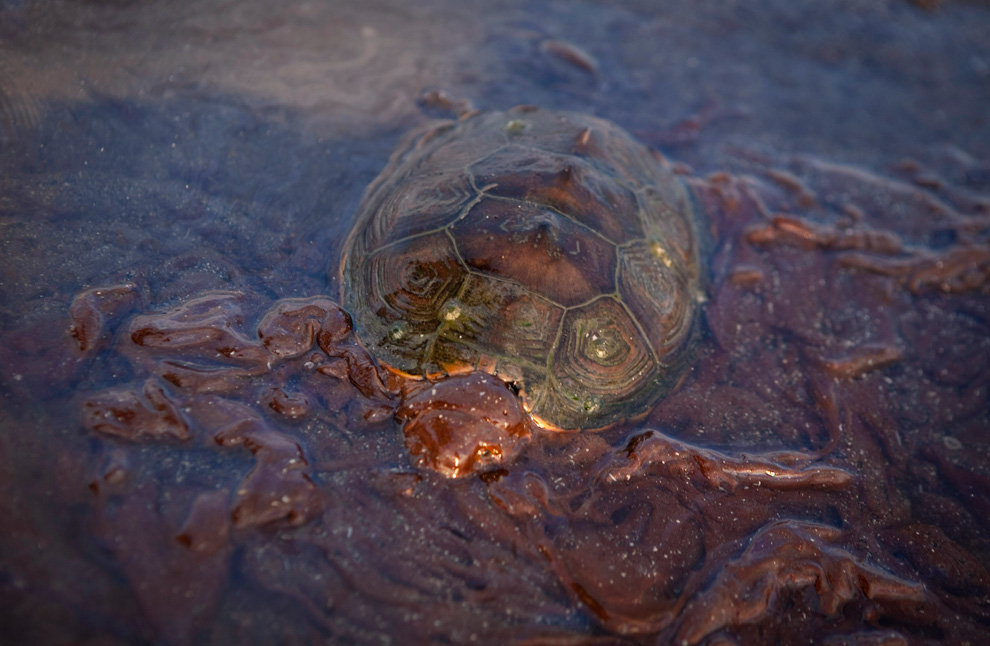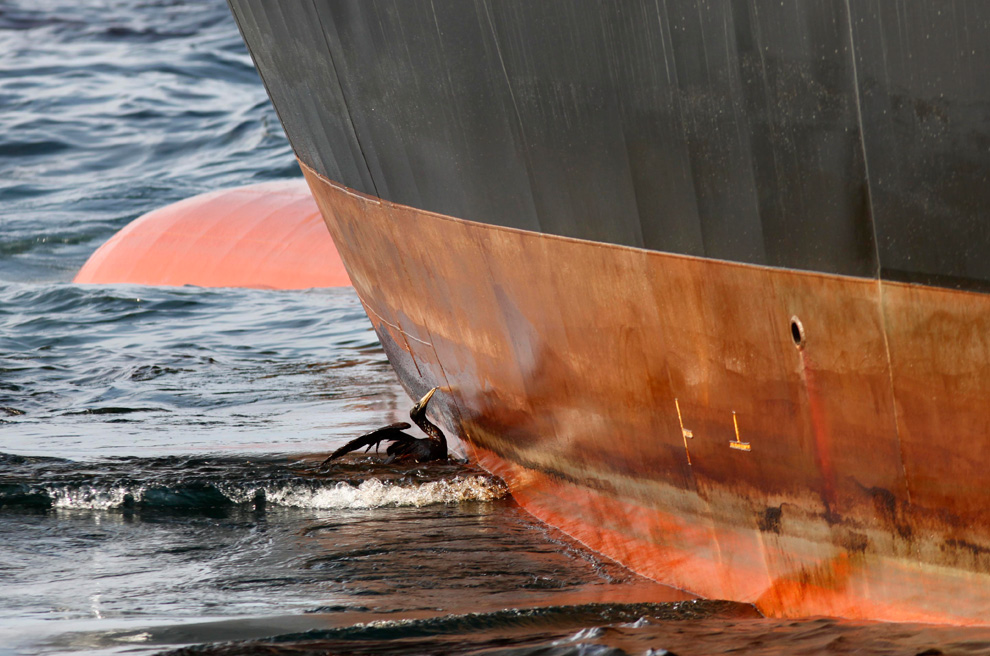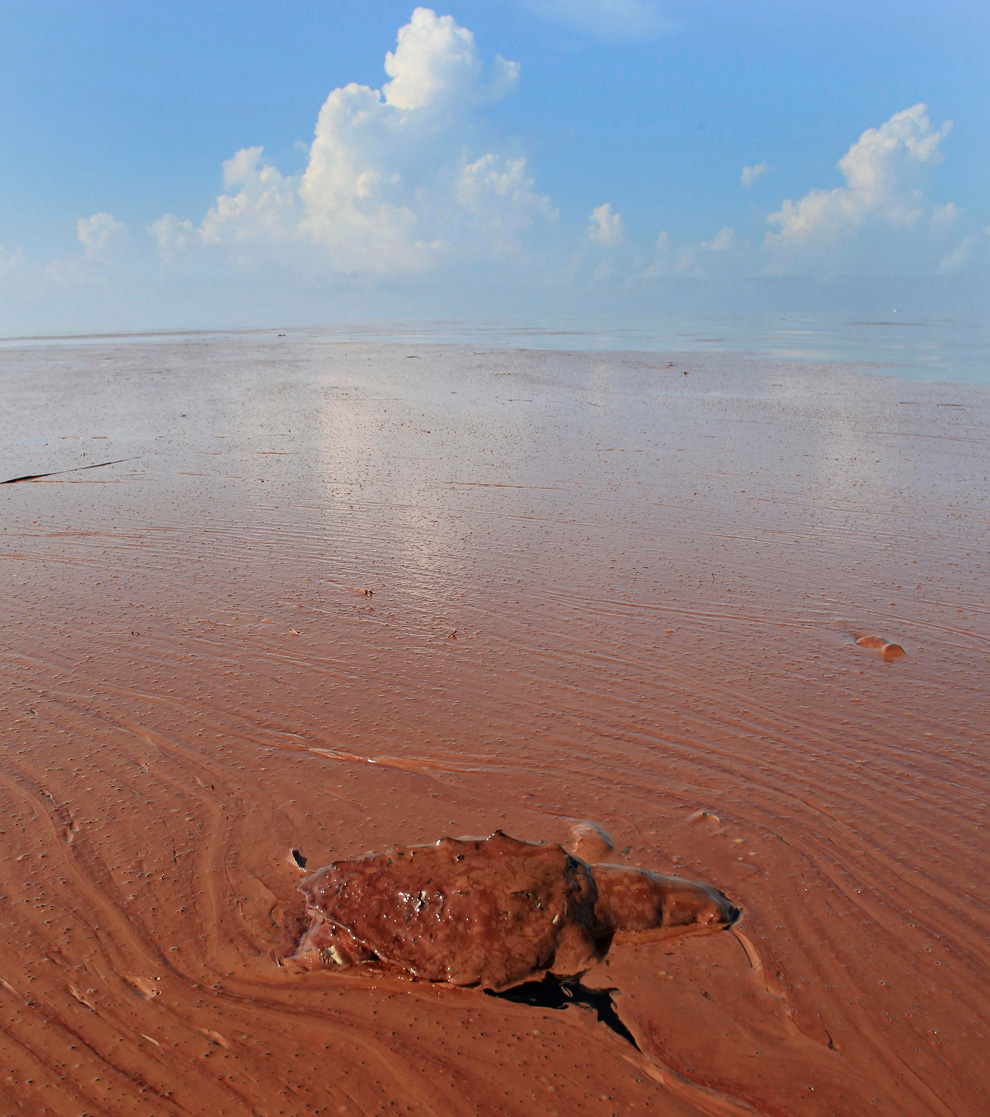Showing posts with label environment. Show all posts
Showing posts with label environment. Show all posts
2010 Arctic Ice Update: It's Melting...
By
Paul
on
Monday, September 13, 2010 at 11:44 PM

Labels: climate, conservation, environment, science and society
Labels: climate, conservation, environment, science and society
BP Climbs Higher On My Shit List
BP seems to be up to some really sleazy stuff. I have zero respect for any organization that tries to pay away an entire community of scientists, just to cover it's ass when the shit hits the fan. Really, really bad form BP. So scientists, please keep your wits about you and help your colleagues in kind. As for BP, I decided to channel my disgust into something a bit less caustic than might actually be appropriate...
Photos of Wildlife Affected By The BP Oil Spill
There is a growing collection of wildlife photos from the gulf oil spill up on the web (e.g. here, here and here), but like so many other wildlife photos in the media many organisms are woefully unlabeled, or even labeled incorrectly (gasp!). I mean come on folks, "bird" and "turtle"? We can do better than that!
Check out the photos below, for example, and if you're an ID-fiend feel free to take a stab at identifying these species (speculation and/or solid IDs are welcomed in the comments section).
On a side note, the media has basically been shut out of most of the affected areas. This basically cuts off public access to these kinds of images which portray the huge impact the oil spill is having on coastal and marine ecosystems. Images like those below or others like these from the Boston Globe, are less common in the press than they should be - so do take some time and check them out.
Photo #1:
Check out the photos below, for example, and if you're an ID-fiend feel free to take a stab at identifying these species (speculation and/or solid IDs are welcomed in the comments section).
On a side note, the media has basically been shut out of most of the affected areas. This basically cuts off public access to these kinds of images which portray the huge impact the oil spill is having on coastal and marine ecosystems. Images like those below or others like these from the Boston Globe, are less common in the press than they should be - so do take some time and check them out.
Photo #1:
A bird covered in oil flails in the surf at East Grand Terre Island along the Louisiana coast Thursday, June 3, 2010. (AP Photo/Charlie Riedel)
Photo #2:
A sea turtle is mired in oil from the Deepwater Horizon oil spill on Grand Terre Island, Louisiana June 8, 2010. (REUTERS/Lee Celano)
Photo #3:
An oil soaked bird struggles against the oil slicked side of the HOS Iron Horse supply vessel at the site of the Deepwater Horizon oil spill in the Gulf of Mexico off the coast of Louisiana Sunday, May 9, 2010. (AP Photo/Gerald Herbert)
Photo #4:
A dead turtle floats on a pool of oil from the Deepwater Horizon spill in Barataria Bay off the coast of Louisiana Monday, June, 7, 2010. (AP Photo/Charlie Riedel)
The First American Oil Spill?
By
Paul
on
Friday, July 2, 2010 at 12:27 AM

Labels: conservation, environment, history, science and society
Labels: conservation, environment, history, science and society
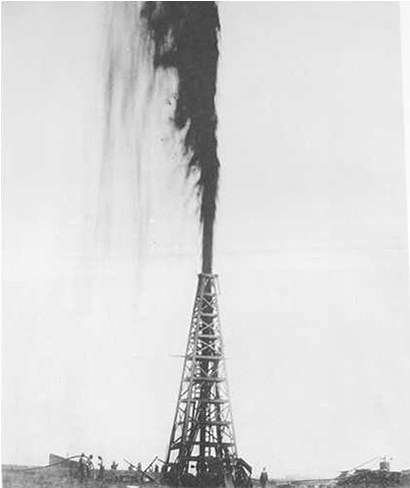
The Lucas Gusher at Spindletop Hill, Jan 10, 1901
[Source: The American Petroleum Institute & PRI]
One of the pivotal drilling attempts occurred at the turn of the century in - you guessed it - Texas. The particular location was on a hilltop called Spindle Top, located near Beaumont, Texas, and the find opened up the vast oil reserves below the Texas soil.
You can read more about those early days in the Hand book of Natural Gas by Henry Palmer Wescott (Yay, Google books!).
So why am I bringing all this up? Perhaps not ironically, this early find started with a bit of an oil spill - nothing like the current disaster in the Gulf of Mexico, but it still caught my attention as an example of the real challenges we still face tapping these deep, pressurized pockets of crude.
While I'm poking around in historical documents, here's part of a newspaper article published in the Houston Daily Post shortly after the find on January 11, 1901.
OIL STRUCK NEAR BEAUMONT.
A Stream of Petroleum Shot Into the Air for a Hundred Feet.
Prospector Who Has Been at Work for Two Years
Has His Faith Rewarded -- The Flow Is Esti-
mated at 5000 Barrels Per Day.
Beaumont, Texas. January 10.--Beaumont is excited tonight and it has good reason to be. About three mils south of the city there is spouting an oil well the equal of which can not be seen elsewhere in the United States and probably in the world.
Captaion A. F. Lucas, a geologist of Washington, D. C., made the lucky strike. The captain has been prospecting in the vicinity of Beaumount for more than two years. He has spent thousands of dollars with indifferent results until this morning, when the inside pipe in a hole in which he was operating blew high into the air, and it was followed by a six-inch stream of oil, which spouts nearly fifty feet higher than the sixtey-foot derrick.
...
The post correspondent visited Captain Lucas this afternoon, but that gentleman was so happy over his strike that he would not talk. He merely hugged the reporter and pointing to oil as it sailed high into the air, said: "Its equal can not be seen on this earth." Under existing conditions there is no way of estimating the flow of oil, but Captain Lucas says 5000 barrels per day would be exceedingly low...
By today's standards, it would indeed be exceedingly low, but at the time - that was quite a gusher! That well spewed oil for a few days before it was finally brought under control (if I can trust my recollection of what I heard on the History Channel...). While I doubt it got any bad press at the time - for better or worse - it went on to help fuel the last century of the modern industrial era.
Science, Innovation and the BP Oil Spill
By
Paul
on
Sunday, May 23, 2010 at 1:19 AM

Labels: conservation, environment, science and society, science literacy
Labels: conservation, environment, science and society, science literacy
Bill Nye (yup, the Science Guy) critiques suggestions to clean up the ongoing BP oil spill. Decent commentary on some challenges posed by the spill, and the fundamental importance of scientific and technological expertise the effort will require.
Methane Hydrate Crystals Hamper Efforts to Contain BP Oil Spill
So what is a "methane hydrate", and how do methane and sea water mix to form the solid crystals currently growing on BP's 4-story containment dome? The beauty of basic science is that we already know something about these crystals, and that knowledge may be the key to overcoming this setback in the ongoing efforts to manage the BP oil spill in the Gulf of Mexico.
Also known as methane clathrate, these crystals are a mixture of methane (CH4) and water (H2O) in which methane molecules are enclosed in a cage of water molecules (see the inset in the picture of the flaming ice on the left). Together, these complexes form the crystalline solid (see Figure 2 below) known as methane hydrate.
To understand more about how this mixture forms a solid at relatively high temperatures (Figure 3), let's first do a quick review of the physics of freezing and melting.
Also known as methane clathrate, these crystals are a mixture of methane (CH4) and water (H2O) in which methane molecules are enclosed in a cage of water molecules (see the inset in the picture of the flaming ice on the left). Together, these complexes form the crystalline solid (see Figure 2 below) known as methane hydrate.
To understand more about how this mixture forms a solid at relatively high temperatures (Figure 3), let's first do a quick review of the physics of freezing and melting.
The Cost of the Gulf Coast Oil Spill
By
Paul
on
Friday, April 30, 2010 at 1:30 PM

Labels: birds, conservation, environment, humans vs nature, mammals, natural resources, nature, reptiles, technology
Labels: birds, conservation, environment, humans vs nature, mammals, natural resources, nature, reptiles, technology
This post will be updated regularly. There are links below to related articles, blog posts, and other resources on the flora and fauna affected by the gulf coast BP oil spill. If you know of other links or suggestions, please send them to me via email or in the comments below.
Bloggers, biologists, naturalists, science writers... I need your help. Life is about to get very bad for the inhabitants of the Gulf Coast, with the first waves of raw crude oil projected to reach shore in the coming days, if it hasn't already. While this will certainly have an impact on local economies and an even bigger impact on those who make their living from those waters, there will be a great many other living organisms and even entire ecosystems that will be utterly devastated by the spill.
So why don't more people seem to care? While there is no single answer to that question , it is in part because pretty much every single person has absolutely no idea that most of the affected species even exist. It's hard to fault someone for not caring about something they don't even know exists, and I'd bet most people would care if they only knew... That, my friends, is where I need your help!
Bloggers, biologists, naturalists, science writers... I need your help. Life is about to get very bad for the inhabitants of the Gulf Coast, with the first waves of raw crude oil projected to reach shore in the coming days, if it hasn't already. While this will certainly have an impact on local economies and an even bigger impact on those who make their living from those waters, there will be a great many other living organisms and even entire ecosystems that will be utterly devastated by the spill.
So why don't more people seem to care? While there is no single answer to that question , it is in part because pretty much every single person has absolutely no idea that most of the affected species even exist. It's hard to fault someone for not caring about something they don't even know exists, and I'd bet most people would care if they only knew... That, my friends, is where I need your help!
How you can help...
To help raise awareness of the environmental costs of the gulf coast oil spill, I'm asking others to take at least one of the follow actions to draw attention to particular species and ecosystems affected by the spill:- Share this post, and this request with others, and be creative about it -- encourage your local news paper's science writer to showcase the environmental costs of the spill, organize a public talk by local conservation groups, university or government researchers, and so on. Check back now and then and share some of the posts below with your family, friends and coworkers.
- If you have a blog, choose an organism -- plant, animal, or other -- and tell the rest of us about it. No blog? No problem... you can always write a guest-post for someone else's blog, or use other media outlets. You can make a video and post it on youtube, send some info you your local newscasters, do whatever you can think of! Share pictures, natural history facts, economic value, whatever you can come up with to convey to the public why anyone should give a rat's tail about the demise of your chosen subject. Once you've done that, if it's on the web, please send me the link and I'll include it below.
- Stash some cash if you can, and consider donating to the recovery efforts. I'll post more information below once I get the time to offer up suggestion.
Related Links...
Birds- Bad Place, Bad Timing for and Oil Spill | Round Robin (Cornell Lab of Ornithology)
- Gulf Coast Birds in Danger | Frank Gill, PhD. (CNN Opinion piece)
- West Indian Manatee | The Obligate Scientist
- Impacts on Wildlife of the Gulf of Mexico Oil Spill | Ninjameys (Natural History Blog)
- Watching and Waiting | Living Alongside Wildlife
- Oil Spill Wildlife Rescue: Why Some Animals Receive Priority Care | Discovery News
- Pictures: Gulf Oil Spill Hits Land -- And Wildlife | National Geographic
- Photos related to the 2010 gulf coast oil spill | www.Flickr.com
- Info on Methane Hydrates | The Obligate Scientist
- Gulf Oil Slick | Blog with great areal footage, environmental news
- NOAA's website on the Deep Water Horizon Spill, Gulf of Mexico | NOAA.gov
- USFWS wesbite on the oil spill response | FWS.gov
- EPA's website on the spill | EPA.gov
- Tracking the oil spill | CNN
- Cool Green Science | Nature Conservancy's Blogs
- Gulf Coast Wildlife Workers Prepare For Worst | NPR's All Things Considered
Subscribe to:
Posts (Atom)


